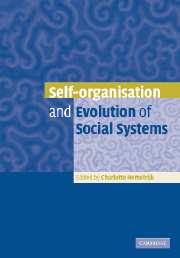Book contents
- Frontmatter
- Contents
- List of contributors
- Preface
- Introduction
- 1 From unicellular to multicellular organisation in the social amoeba Dictyostelium discoideum
- 2 Optimality of communication in self-organised social behaviour
- 3 The interplay of intracolonial genotypic variance and self-organisation of dominance hierarchies in honeybees
- 4 Traffic rules of fish schools: a review of agent-based approaches
- 5 A process-oriented approach to the social behaviour of primates
- 6 Order and noise in primate societies
- 7 Self-organisation in language
- 8 Dictatorship effect of majority rule in voting in hierarchical systems
- 9 Natural selection and complex systems: a complex interaction
- 10 Interlocking of self-organisation and evolution
- Index
- References
1 - From unicellular to multicellular organisation in the social amoeba Dictyostelium discoideum
Published online by Cambridge University Press: 07 December 2009
- Frontmatter
- Contents
- List of contributors
- Preface
- Introduction
- 1 From unicellular to multicellular organisation in the social amoeba Dictyostelium discoideum
- 2 Optimality of communication in self-organised social behaviour
- 3 The interplay of intracolonial genotypic variance and self-organisation of dominance hierarchies in honeybees
- 4 Traffic rules of fish schools: a review of agent-based approaches
- 5 A process-oriented approach to the social behaviour of primates
- 6 Order and noise in primate societies
- 7 Self-organisation in language
- 8 Dictatorship effect of majority rule in voting in hierarchical systems
- 9 Natural selection and complex systems: a complex interaction
- 10 Interlocking of self-organisation and evolution
- Index
- References
Summary
The development of the social amoeba Dictyostelium discoideum
Development of a vertebrate embryo typically involves the generation of millions of cells that differentiate into hundreds of cell types to form a wide variety of different tissues and organs. Some cell types arise and differentiate in situ at the right position at the right time of development; however, many cell types have to migrate during development over considerable distances to reach their final destination. One of the best understood mechanisms guiding long-range cell movement is chemotaxis. Chemotactic cell movement is a key mechanism in the multicellular development of the social amoeba Dictyostelium discoideum. Its development is in many respects much simpler and more amenable to experimental analysis than that of vertebrates. The cells proliferate in the vegetative stage as single amoebae, which live in the soil and feed on bacteria. When the population size increases, the cells in the centre of the colony will start to starve, and starvation for amino acids acts as a signal for the cells to enter a multicellular developmental phase. Up to 105 cells aggregate to form a multicellular aggregate which transforms into a cylindrical slug. The slug migrates under the control of environmental signals such as light and temperature gradients to the soil surface, where low humidity and overhead light trigger the conversion of the slug into a fruiting body. The fruiting body consists of a stalk of dead cells supporting a mass of spores.
- Type
- Chapter
- Information
- Publisher: Cambridge University PressPrint publication year: 2005



